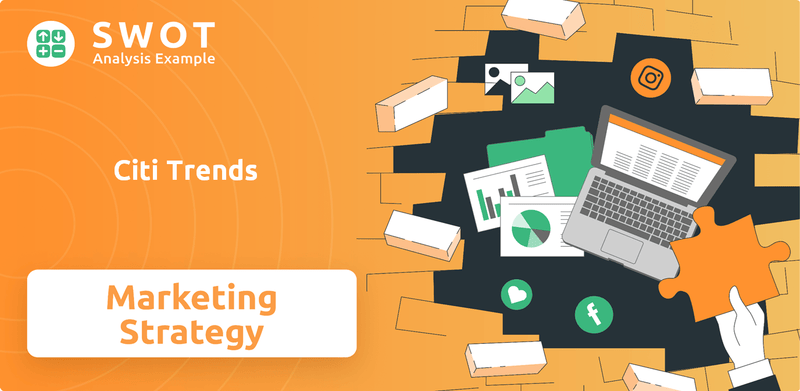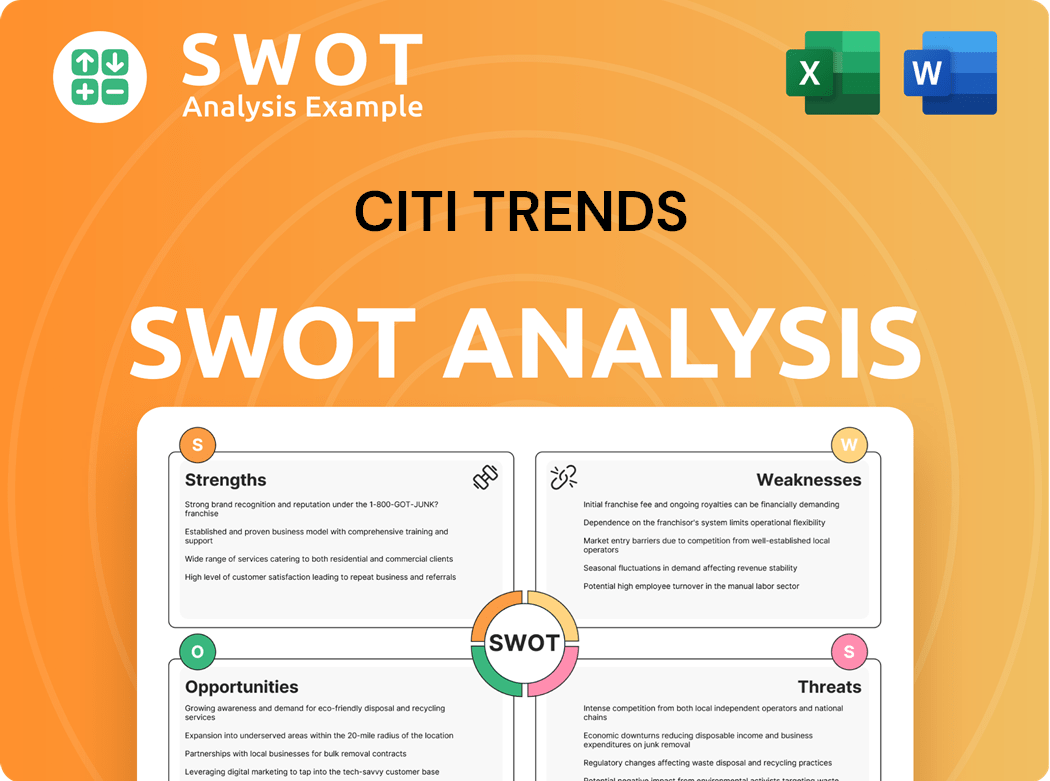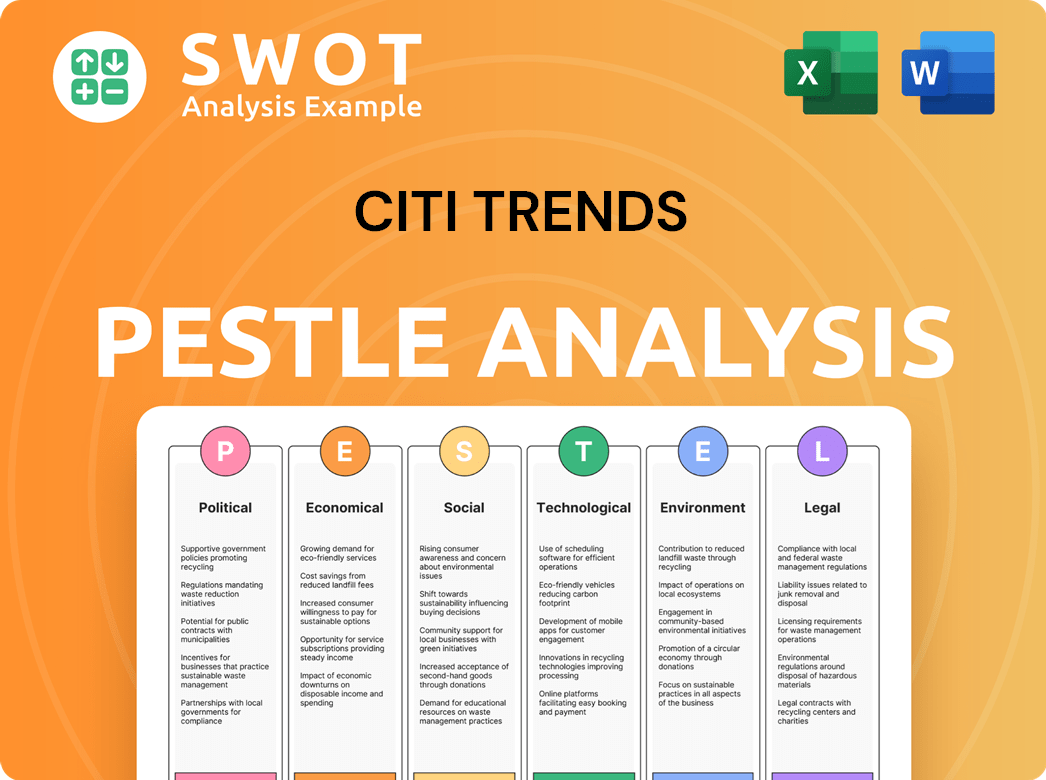Citi Trends Bundle
How is Citi Trends Winning in the Retail Game?
In the bustling world of retail, where competition is fierce, understanding a company's sales and marketing strategy is key to its success. Citi Trends, a value-priced retailer, has carved a niche for itself, but how does it attract customers and maintain its market share? This article explores the Citi Trends SWOT Analysis, sales strategy, and marketing tactics that drive its performance.

Citi Trends' recent transformation, highlighted by impressive first-quarter fiscal 2025 results, underscores the importance of a robust business model. This success stems from a refined operating model, dedicated personnel, and a strong customer focus, all contributing to Citi Trends' financial performance. We'll examine how the company's marketing mix, including its social media marketing and advertising strategy, fuels its sales growth strategies and strengthens its brand positioning within its target market.
How Does Citi Trends Reach Its Customers?
The sales strategy of Citi Trends centers on a multi-channel approach, with physical retail stores forming the cornerstone of its operations. The company strategically positions its stores in urban and underserved communities to reach its target market of budget-conscious consumers. This strategy is supported by a growing online presence to cater to evolving consumer preferences.
As of May 3, 2025, the company operated a network of 591 stores across 33 states, primarily in the Southeastern United States. These stores are typically located in neighborhood strip shopping centers, offering easy access to low and moderate-income consumers. The company's commitment to its physical retail footprint remains strong, with plans to open up to 5 new stores and remodel approximately 50 locations in fiscal 2025, demonstrating a cautious expansion strategy.
Citi Trends also leverages an omnichannel retail approach, integrating online sales with its physical stores. In 2023, digital sales reached $59.3 million, accounting for 8.4% of total revenue, with online sales increasing by 15.2% year-over-year. This indicates a growing emphasis on digital adoption to meet changing consumer demands. For more insights into the company's financial performance, consider exploring the information available for Owners & Shareholders of Citi Trends.
Citi Trends strategically places its stores in areas with high concentrations of its target demographic. These locations are typically in neighborhood strip shopping centers, providing convenient accessibility.
The company has adopted an omnichannel retail approach, with a growing emphasis on digital sales. Online sales are a significant part of the overall sales strategy.
Citi Trends plans to open new stores and remodel existing locations. This demonstrates a commitment to expanding its physical presence while enhancing its existing store network.
The integration of physical stores and online sales is a key component of the company's strategy. This approach enables Citi Trends to reach a wider customer base.
Citi Trends utilizes a multi-channel approach, with physical retail stores and online sales as primary channels. The company's sales strategy focuses on physical stores and a growing online presence.
- Physical Retail Stores: The primary sales channel, strategically located in urban and underserved communities.
- Online Sales: A growing channel, contributing to a significant portion of the total revenue.
- Store Remodels and New Openings: Ongoing investments in both existing and new locations.
- Omnichannel Integration: Seamless integration between physical stores and online platforms.
Citi Trends SWOT Analysis
- Complete SWOT Breakdown
- Fully Customizable
- Editable in Excel & Word
- Professional Formatting
- Investor-Ready Format

What Marketing Tactics Does Citi Trends Use?
The marketing tactics of the company are designed to reach its target audience effectively and drive sales. They combine digital and traditional methods, focusing on both awareness and direct engagement. This approach helps the company stay relevant and competitive in the fast-fashion market.
The company's strategy includes a strong emphasis on data-driven decision-making. This is evident in their store expansion plans and customer segmentation efforts. By analyzing data, they aim to optimize their operations and tailor their marketing efforts to specific customer needs, particularly those of budget-conscious shoppers.
Promotional pricing is a key element of the company's marketing mix, with frequent sales and discounts. A new AI-powered allocation system is set to launch in 2025, promising even greater precision in inventory management and margin improvement, demonstrating a commitment to leveraging technology for enhanced financial performance.
The company utilizes digital marketing, including social media and influencer partnerships, to engage with younger demographics like Gen Z and millennials. These efforts are designed to promote fast-fashion trends at affordable prices, driving engagement and sales. This strategy is a core component of their Citi Trends marketing strategy.
Past campaigns, such as the 'Spin to Win' mobile game advertised on Facebook and mobile ad networks, have been successful in driving customer engagement. These campaigns target specific demographics, such as 18 to 34-year-old females, and are geographically targeted to reach customers near store locations. Such initiatives help boost the company's social media marketing.
Geolocation studies and data-driven strategies guide the company's store expansion. This approach helps in identifying optimal locations and optimizing the store fleet for maximum reach and efficiency. This data-driven approach is a key part of their expansion plans.
The company focuses on customer segmentation, particularly targeting budget-conscious consumers. This allows them to tailor their marketing messages and promotional offers to resonate with specific customer segments. Understanding the Citi Trends target market is crucial.
Promotional pricing strategies, including clearance sales, markdown events, and seasonal discounts, are frequently used to attract customers. These strategies are designed to drive sales and manage inventory effectively. This is an important aspect of their Citi Trends pricing strategy analysis.
The 'Ready. Set. GIFT!' campaign, for example, was successful during the 2023 holiday season. These campaigns aim to capitalize on seasonal shopping trends and boost sales. This highlights their Citi Trends sales growth strategies.
In 2025, the company plans to launch an AI-powered allocation system. This system is expected to improve inventory turnover and margin growth. This demonstrates the company's commitment to leveraging technology for enhanced operational efficiency and financial performance. This is a key component of their Citi Trends business model.
- AI-Powered Allocation: Implementing an AI system to optimize inventory management.
- Customer Engagement: Utilizing social media and mobile marketing to connect with customers.
- Promotional Offers: Employing frequent sales and discounts to drive sales.
- Data Analysis: Using data to inform store locations and customer segmentation.
Citi Trends PESTLE Analysis
- Covers All 6 PESTLE Categories
- No Research Needed – Save Hours of Work
- Built by Experts, Trusted by Consultants
- Instant Download, Ready to Use
- 100% Editable, Fully Customizable

How Is Citi Trends Positioned in the Market?
The brand positioning of the company is centered around value and urban fashion, specifically targeting African American and multicultural families. This approach is designed to offer trendy, affordable clothing, appealing to style-conscious shoppers. The company differentiates itself by providing a mix of branded and private-label merchandise at significantly reduced prices, up to 70% off compared to department and specialty stores.
The visual identity and tone of voice are tailored to resonate with the target demographic, focusing on fashion, value, and a dynamic in-store experience. The company's strategy emphasizes a culturally relevant shopping experience, which fosters customer loyalty and encourages frequent visits. The average price points, ranging from $10 to $50 per item, further reinforce the value proposition, making fashion accessible to a broad audience.
The company's strategic focus on 'off-price' and 'extreme value branded product' is expected to drive an incremental 10% of top-line revenue over time. This focus, combined with culturally relevant offerings, creates a distinct competitive advantage in the retail market. To learn more about the company's strategic direction, consider reading about the Growth Strategy of Citi Trends.
The company primarily targets African American and multicultural families, tailoring its merchandise and marketing to resonate with their preferences. This targeted approach helps the company build strong customer loyalty.
The brand emphasizes value, offering quality merchandise at affordable prices. This value proposition is crucial in attracting and retaining customers, especially in a competitive retail environment. The company's pricing strategy is a key component of its marketing strategy.
The company's commitment to serving its target market with culturally relevant offerings creates a distinct competitive advantage. This focus helps the company stand out in the market.
The company focuses on creating a dynamic in-store environment to enhance the shopping experience. This includes visual merchandising and store layout, designed to engage customers.
Citi Trends Business Model Canvas
- Complete 9-Block Business Model Canvas
- Effortlessly Communicate Your Business Strategy
- Investor-Ready BMC Format
- 100% Editable and Customizable
- Clear and Structured Layout

What Are Citi Trends’s Most Notable Campaigns?
The sales and marketing strategies of the company are centered around key campaigns designed to drive growth and enhance customer experience. These initiatives are crucial for maintaining and improving the company's financial performance and market position. The company's approach combines strategic transformations, store enhancements, and targeted promotions to attract and retain customers.
A primary focus is the strategic transformation journey, which includes initiatives that have shown positive results. Another key element of the company's strategy involves store remodels and new store openings. These efforts are designed to create a more appealing and efficient shopping environment, directly impacting the customer experience. The company’s approach also includes the implementation of a loyalty program and community engagement through initiatives like the 'Black History Makers' program.
The company's "Ready. Set. GIFT!" holiday campaign is an example of its marketing efforts. The company also focuses on targeted promotional discounts to boost customer acquisition and retention. The company's commitment to its community is also apparent in the 'Black History Makers' program, launched in 2021, which promotes Black business owners.
The company's strategic transformation journey has shown tangible results, with total sales increasing by 8.3% to $201.7 million in Q1 2025. Comparable store sales grew by 9.9%, and the two-year stack reached 13.0%. This performance is a key element of the company's sales growth strategies.
In fiscal year 2025, the company plans to remodel approximately 50 stores and open up to 5 new locations. These remodels are designed to enhance the in-store experience, aligning with the goal of delivering exceptional store experiences and improving the store location strategy. This is a crucial part of the company's expansion plans.
The company uses targeted promotional discounts to drive customer acquisition and retention. This strategy is a key component of its marketing mix and aims to enhance customer retention. The company's marketing campaign examples include the "Ready. Set. GIFT!" holiday campaign.
The loyalty program, launched in 2024, offers members exclusive discounts and early access to sales. This initiative is part of the company's customer retention tactics and helps to build brand positioning. It is a significant part of the company's efforts to understand its Target Market of Citi Trends.
The CITIcares Council launched the 'Black History Makers' program in 2021, promoting in-store displays and social media campaigns. This program encourages Black business owners to apply for grants. This demonstrates the company's commitment to its community and its broader marketing strategy.
- The program supports the company's brand positioning.
- It enhances the company's social media marketing.
- It aligns with the company's value proposition.
- The initiative contributes to the company's overall marketing strategy.
Citi Trends Porter's Five Forces Analysis
- Covers All 5 Competitive Forces in Detail
- Structured for Consultants, Students, and Founders
- 100% Editable in Microsoft Word & Excel
- Instant Digital Download – Use Immediately
- Compatible with Mac & PC – Fully Unlocked

Related Blogs
- What are Mission Vision & Core Values of Citi Trends Company?
- What is Competitive Landscape of Citi Trends Company?
- What is Growth Strategy and Future Prospects of Citi Trends Company?
- How Does Citi Trends Company Work?
- What is Brief History of Citi Trends Company?
- Who Owns Citi Trends Company?
- What is Customer Demographics and Target Market of Citi Trends Company?
Disclaimer
All information, articles, and product details provided on this website are for general informational and educational purposes only. We do not claim any ownership over, nor do we intend to infringe upon, any trademarks, copyrights, logos, brand names, or other intellectual property mentioned or depicted on this site. Such intellectual property remains the property of its respective owners, and any references here are made solely for identification or informational purposes, without implying any affiliation, endorsement, or partnership.
We make no representations or warranties, express or implied, regarding the accuracy, completeness, or suitability of any content or products presented. Nothing on this website should be construed as legal, tax, investment, financial, medical, or other professional advice. In addition, no part of this site—including articles or product references—constitutes a solicitation, recommendation, endorsement, advertisement, or offer to buy or sell any securities, franchises, or other financial instruments, particularly in jurisdictions where such activity would be unlawful.
All content is of a general nature and may not address the specific circumstances of any individual or entity. It is not a substitute for professional advice or services. Any actions you take based on the information provided here are strictly at your own risk. You accept full responsibility for any decisions or outcomes arising from your use of this website and agree to release us from any liability in connection with your use of, or reliance upon, the content or products found herein.